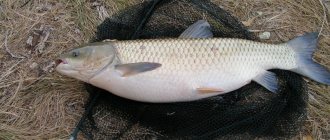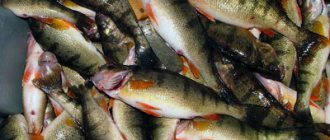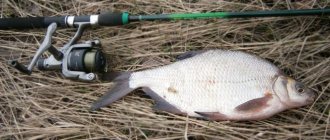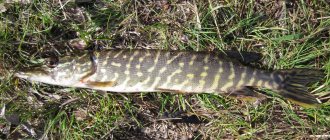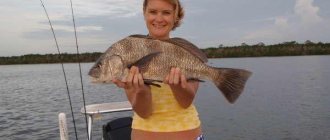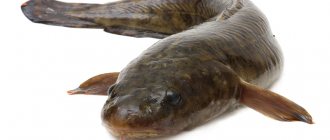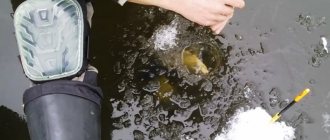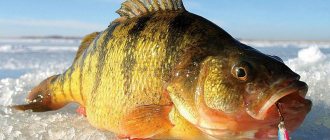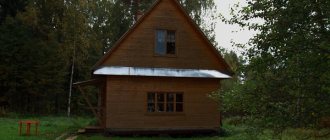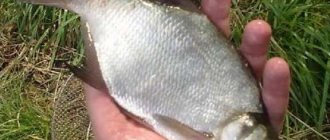Types of leeches for fishing
Leech
Over 80 species of leeches live in the freshwater bodies of our country, but not all of them can serve as bait. Leeches can be found on the underwater part of reeds, sedges, and other aquatic plants, on the underside of water lily leaves, under stones or other objects located at the bottom.
Quite often, novice fishermen try to use a hard leech, klepsin.
, grayish-greenish in color with specks, almost round in shape, 20-40 mm long. However, experience shows that even with intense biting, fish are reluctant to take the lure. Apparently, it should be used only when there is no other bait available.
The largest horse leech
It is used very rarely, mainly when fishing in the current, since, when put on a hook, it curls up into a ball. Only pike, ide, and large perch are caught with a horse leech. The bites are not numerous, but, as a rule, record-breaking specimens for the reservoir are taken with the bait. Horse leeches live under stones; they lie or crawl freely in wet soil, at the border of water.
Of greatest interest are the small (from 2 to 5 cm) soft leeches Herpobdella
. Their coloring is the most unexpected: reddish-brown, gray, black, with specks. It is easy to distinguish them from other leeches of the same size: if you move them, they do not curl up into a ball, but quickly resume movement, stretching out to the full length of their body.
Where does the leech live?
Photo: Leech in Russia
All leeches (without exception) are predators. They mostly feed on blood. They predominantly parasitize warm-blooded animals or mollusks, but often eat other worms entirely. Leeches are (primarily) inhabitants of fresh waters, but there are also terrestrial forms that live in wet grass (that is, terrestrial species of leeches). Several species are marine forms (Pontobdella).
The medicinal leech, Hirudo medicinalis, has gained the greatest fame. The worm can reach up to 10 cm in length and 2 cm in width. In color it is usually black-brown or black-green; there is a longitudinal patterned pattern with a reddish tint on the back. The belly is light gray in color, with 5 pairs of eyes located on the 3rd, 5th and 8th rings and incredibly strong jaws. Regarding its habitat, the medicinal leech is mostly distributed in the swamps of southern Europe, Russia and the Caucasus.
Interesting fact: Mexican doctors use a different leech - Haementaria officinalis. It has a similar, even slightly more pronounced effect on the human body.
Among leeches there are also poisonous species, the bite of which poses a great danger to human life and health. For example, N. mexicana, living in Central America. That is, unlike a medical leech, in addition to hirudin, it injects toxic substances into the body of the animal to which it is attached. This gives her the opportunity to subsequently not only enjoy the taste of his blood, but also evaluate the quality of the meat. This leech is a typical predator, not disdainful of providing itself with food in this way.
In the tropics of Asia, in humid forests and grass, another, no less dangerous leech is common - Hirudo ceylonica and its closely related species, which cause pain when bitten. The bleeding caused by it is very difficult to stop. That is why it is not used for medicinal purposes. The Caucasus and Crimea have their own endemic types of leeches. For example, Nephelis vulgaris is a small worm with a thin and very narrow body. The color is gray, sometimes there is a brown pattern on the back. The second representative is Clepsine tessel ata, a Tatar leech, the distinctive feature of which is its wide and oval body.
It is also notable for the fact that the Tatars use it in folk medicine, although official hirudotherapists do not recognize the use of this type of leeches. But on the muddy bottom of the Caspian and Azov lives a sea leech - Archaeobdella Esmonti. This worm is pink in color and does not have a posterior sucker. The northernmost leech is Acanthobdella peledina, found in the Lake Onega basin.
Now you know where the leech is found. Let's see what this animal eats.
Baiting leeches on a hook
Leech on a hook
There are two ways to bait a leech on a hook:
- Nozzle via suction cup.
Pierce the body of the leech so that the hook passes through the front part and comes out in the middle of the suction cup, then we pierce the body of the leech so that the hook comes out. The hook sting is not masked. - Nozzle through the middle of the body.
This method of baiting allows the leech to wriggle in the water, which will certainly tempt the fish to treat itself. This method is applicable in cases where small perches do not try to “pluck” the leech. A leech suspended in the depths of the water wriggles, attracting fish to a much greater extent than when it is attached to one end of the body. For bottom fishing, it is recommended to attach several leeches at once; sometimes, to improve the bite, you can add a crawler to them in company.
How to put bait on a hook
Each fisherman has his own way of attaching leeches. It’s easier with herpobdels; they can be pierced in the head area and pulled over the forearm, like a dung worm - with a stocking. Some pierce the body from the side and bring the sting out through the suction cup. If the purpose of live bait is to attract trophy fish, then small brown leeches are planted in several pieces.
You can also attach a large false horse leech to a hook in different ways. It has one property that negatively affects the fishing result. Having felt a foreign object in its body, that is, a hook, the black leech shrinks into a tight lump, uninteresting to the fish. To keep it mobile and attractive, fishermen cut off its suckers. For the same purpose, it can be turned inside out.
Fishing with a leech is almost always successful. This reliable bait catches most fish, and you don't have to search for it for long. It literally lies under your feet. Video on the topic: Bait for catfish. How to collect leeches for catching catfish. 07:33
Tackle for leech fishing
The gear for leech fishing is quite simple and is made as follows. You need to take a spinning rod of any length with a spinning reel. It is better to use monofilament with a diameter of 0.3 to 0.35 mm as the main line. The line is pulled through a sliding sinker, shaped like a barrel. This form of sinker is preferable, since in the presence of a current it allows the bait to roll along the bottom, creating a cloud of turbidity and, thereby, attracting a predator. The weight of the sinker can vary widely from 10 to 60 g, depending on the depth of the reservoir and the strength of the current.
After that. as the sinker is put on the fishing line, a loop is tied at its end. A small lead pellet is clamped above the loop to prevent the sliding sinker from jumping off. A 20-25 cm long leash made of fishing line with a diameter slightly thinner than the main one is attached to the loop through a swivel. It is best to use hooks of size 6-7 according to the domestic classification. The tackle is ready.
How to catch fish with a leech
It is best to fish using a leech as bait from a boat using tackle with a sliding sinker. The weight of the sinker should be no more than 30-35 grams, with a leash 50-60 centimeters long attached to it, which allows more time to plan the bait in the water. Perhaps the most important stage in preparing for fishing is placing the bait on the hook.
When attaching bait, it is advisable to cut off the sucker from either side of the leech - blood strongly attracts predatory fish, then attach it to the hook from the side of the remaining sucker, but in such a way that the bait can make circular movements in the water.
When attaching a leech covered with mucus to a hook, it is highly advisable to use ordinary cotton gloves.
Fishing with a leech helps in the summer heat to remain with a good catch. Take note of this secret bait!
How to store leeches
If long-term storage is expected, then you cannot do without a wooden barrel, and if you plan to go fishing in the near future, then you can use a glass jar. You need to fill it with water (about 2/3) and place the leeches there. It is advisable to place the jar in a cold basement or on the bottom shelf of the refrigerator. If, of course, the hostess doesn't mind. To ensure that the leeches are not only alive, but also fresh at the time of catching, the water must be changed every 5-6 hours.
How to catch a leech for fishing?
The small klepsin leech is a reliable bait for catching fish of many species that live in the rivers of central Russia. Anyone who has learned to fish with a leech always has a good catch. But fishing with this bait has its own secrets.
Once I spent half a day with a float rod on Pakhra, content with only occasional bites of small roach. No matter how sophisticated I fed, no matter what attachments I used, nothing worked.
And the day was good, and I didn’t want to go home. But the fish didn’t take it... And then a friend called me on my mobile phone and boasted about his excellent catch. It turns out that he was fishing on the same river, not far from me - on a shallow riffle near the Solnechnaya Polyana dacha, and used a small leech as a bait. You can also use black leech as bait
Without hesitation, I went to this riffle, and by the evening, thanks to my friend, who shared the bait with me and discovered the secret of fishing with a leech, I became the owner of a solid catch.
Clepsina is a small, harmless light brown leech, usually 2-4 cm in size. It lives under stones, on the back of water lilies and some other aquatic plants, sometimes on their stems and roots. Prefers water areas adjacent to fast currents, where the water is rich in oxygen.
In summer, the easiest way to collect leeches is from a boat. To do this, you need to move through the thickets of water lilies and, lifting the glossy leaves, inspect their underside.
In spring and autumn, klepsin are collected under stones. This is done like this: in the area of rifts and near dams, boulders are turned over and leeches are found attached to their lower side.
Place the klepsin in a glass jar with a lid, in which you need to make small holes.
A variety of fish love leeches, probably because they are very nutritious as food, and in addition, these leeches are familiar to fish, which prefer to stay in areas where the water is well enriched with oxygen.
A strong stream washing the stones will, no, no, even tear off the leech from them and carry it downstream. The fish is accustomed to such gifts and guards its prey. Leeches are washed away especially well where rivers are regulated and the flow in them accelerates on some days and decreases on others.
Fish activity is higher when the current speed increases. The success of fishing greatly depends on the correct choice of jet. If the fish does not bite on the leech, you need to cast closer or further to find the stream that the fish chose, then success is guaranteed.
You can fish with klepsin throughout the open water season. It is especially attractive for fish in spring and autumn, and in summer, when due to the strong heating of the water most fish move closer to the fast stream, this nozzle is effective even in the heat.
They bait a leech by piercing it with a hook through the middle of the body. This bait is most effective near dams, at spillways, on rifts, near rocky islands, in a word, where clepsin is found on the bottom or in algae.
You can fish from a boat or wade. For the first time, I caught a leech while standing on a riffle in waders, and my friend did it from a boat. Moreover, the fish were not afraid of it, although the depth at the riffle was no more than 1.5 m.
Of course, when fishing in shallow waters, it is difficult to count on large fish, since they are very shy. However, the stable capture of individuals weighing 200-300 g on Pakhra is, you see, not so bad! Moreover, they mixed in roach, white bream, silver bream, chub, perch and even a small asp.
For blind rigging
To catch small fish on the rifts, a float rod with a blind rig is sufficient. If you fish from a boat, take a shorter rod.
A telescopic rod with a length of 4-6 m is well suited. It is very light with high strength and well absorbs jerks of fish, which is very important when fishing it with blind equipment.
It is not always possible to get to the most catchy areas by wading, so it is better to take a longer rod - 6-8 meters.
Regardless of the length of the rod, the equipment must be very thin. The fishing line is colorless, transparent green or transparent blue with a diameter of 0.12-0.13 mm, a float with a round, elongated body and a long keel, with a load capacity of 1-2 g. The float test largely depends on the strength of the current. If the current is weak, it is better to put a 1-gram float; if it is stronger, a 1.5-2 gram float.
When fishing with line fishing, I successfully used floats from the Italian company Venturieri, which have a carefully calibrated shape and high quality workmanship. Fix the float at three points with two pieces of silicone tube on the keel and one on the antenna.
You can get leeches directly from a pond with a silted bottom. If there are a lot of stones along the shore and a little further in the water, then it makes sense to look for leeches under them. A large number of leeches are found in watering areas for cows and other livestock. Before the rain, black leeches can be collected near the shore.
There are many leeches in the reservoirs in which snails live - their natural food. To attract a sufficient number of leeches to one place, you can take chicken giblets or meat scraps from other poultry, wrap them in gauze or, better yet, in a mesh bag, and place it all near the shore.
After several hours of being in the water, a lot of leeches will collect on the meat waste, which will be suitable as bait for fishing for catfish and other large fish.
You can simply use a shovel or rake to take the silt to the shore and level it. You won't have to wait long. When the water flows out, the leeches themselves will begin to crawl out of the silt towards the water. It is best to collect them with a stick and put them in a large box for attachments with water.
Note that the herpobdella has a weak sucker. She is not able to suck strongly on her finger. Therefore, collecting and placing it on a hook is not at all dangerous. At first, you can use small plastic tweezers when inserting.
The process of catching leeches for fishing (herpobdell) is as follows. Using a rake, debris and silt are extracted, which are then raked along the shore.
After waiting for the water to leave, the leeches come out of the mud and strive for the pond. Then you need to start collecting them.
Leeches are collected using tweezers, and often using a stick. These leeches have a weak suction cup, so you don’t have to worry about it sticking to your hand.
It is better to store them in a glass jar with a small amount of water. You can plant up to 50 herpobella in it.
Herpobdella is also good because you can catch from one to several fish per individual. But fishing for roach, ide, and dace most often ends in the loss of the bait, which cannot be said, for example, about catching perch.
Take about twenty to thirty “helpers” with you per day. Provided that this is the only thing that will catch fish, it will be quite enough for you.
Peculiarities
The key features when fishing for leeches are the methods of hooking them:
- through the suction cup . The body is pierced so that the hook penetrates through its anterior zone and comes out near the large sucker. The sharp part of the hook does not need to be hidden, and the size is taken in accordance with the size of the fish that you plan to catch;
- through the center of the body . This method is used when small fish will not “tug” the leech. A leech that is suspended in the depths of the water most often wriggles and makes movements, thereby attracting fish more than if it were attached to one end of the body.
With this baiting method, they begin to shrink, especially when the water temperature is too low. Of course, then she is already quite motionless. To prevent curling, you can place a small plastic tube on the hook of such a width that the leech’s sucker can fit in it. When attached to it, the leech will no longer be able to curl up into a ball.
When hunting using bottom equipment, you can take several leeches at once. This may improve the bite.
Don’t rush to hook; zero bites are rare. Perch bites very greedily on a pretty leech, so you often can’t do without an extractor.
In winter, many fishermen buy leech bait in a regular store, where they are also found in food bloodworms. This is an indispensable bait for catching large perches on the first ice.
Features of character and lifestyle
Photo: Leech in water
It is impossible not to pay attention to the peculiarities of the method of movement of leeches. At each end of the leech's body there are suction cups, through which it can attach to the surface of underwater objects. Suction and subsequent fixation is carried out by the front end. The leech moves by bending into an arc. In parallel with this, it will not be difficult for a leech to move through the water column - blood-sucking worms are able to swim very quickly, bending their body in waves.
Interesting fact: Adjusted for the characteristics of the leech’s lifestyle, in medical practice, before it is installed on a patient, leeches are examined and treated with special reagents - this reduces the likelihood of a person becoming infected with infectious diseases. Immediately after use, the “spent” leech must be removed by applying a swab with alcohol to its head end. Contrary to the popular stereotype, getting rid of an unwanted leech will not be difficult - it will be enough to pour a small amount of salt onto the suction cup that will attach it to the skin.
We also must not forget that leeches, when attacking humans, cause a disease called hirudinosis. Most often, leeches leave their prey at the moment of saturation, when the worm begins to realize that it is full and that it no longer needs it. The process of consuming blood can take her from 40 minutes to 3-4 hours.

